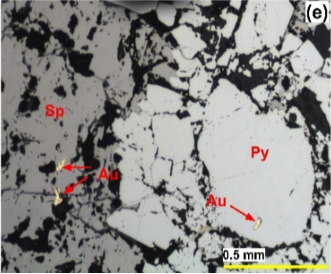Geochemical Characteristics of Metamorphic Rock-Hosted Gold Deposit At Onzon-Kanbani Area, Central Myanmar
DOI:
https://doi.org/10.24273/jgeet.2017.2.3.410Keywords:
Mogok Metamorphic Belt, Fracture filling vein, Hydrothermal alteration, Fluid boilingAbstract
Gold and associated base metal mineralization of Onzon-Kabani area located in the western border of generally N-S trending Mogoke Metamorphic Belt where well-known Sagaing fault is served as a western boundary of this area. In this research area, many artisanal and small-scale gold mines were noted in last three decades. Gold mineralization is hosted in marble and gneiss unit of research area but most common in marble unit. Variety of igneous intrusions are also observed in research area. Mineralizations are observed as fissure filling veins as well as lesser amount of disseminated nature in marble unit. Mineralogically, gold are associated with other base metal such as pyrite, galena, sphalerite, chalcopyrite, marcasite and arsenopyrite. Hydrothermal alteration halos are developed in peripheral of hydrothermal conduits or mineralization veins from proximal to distal such as 1) silicic, 2) sericite-illite, and 3) propylitic alteration. Most of hydrothermal minerals from each altered zones showed that near neutral condition of pH (e.g. adularia, calcite, illite, sericite and chlorite). Alternatively, hydrothermal alteration zones that show with ore minerals such as native gold, electrum, sphalerite, galena, chalcopyrite, arsenopyrite and marcasite which mostly observed in silicic alteration zone. Typical boiling characters of vein textures and fluid inclusion petrography are observed in hydrothermal system of research area. Boiling, cooling and mixing are possiblily responsible for gold deposition in hydrothermal system. In this paper, authors are documented to clarify the type of mineralization based on hydrothermal alterations, ore and gangue mineral assemblages and fluid inclusion study. All of these data can describe and play an important role for both with respect to understanding deposit genesis and in mineral exploration.
Downloads
References
Bender, F., 1983. Geology of Burma, 293 p. Gebrüder Borntraeger, Berlin and Stuttgart.
Bodnar, R.J., 1993. Revised equation and table for determining the freezing point depression of H 57, 683–684.
Evans, A.M., 1987. An Introduction to Ore Geology, 2nd edn. ed. Blackwell, Oxford.
Gregg and Jaireth, S.D.G. and M., 1995. Quartz textures in epithermal veins, Queensland; classification, origin and implication. Econ. Geol. 90, 1841–1856.
Hyndman, D.W., 1986. Petrology of Igneous and Metamorphic Rocks. Geol. Mag. 123, 88–89. doi:10.1017/S001675680002673X
Metcalfe, I., 2009. Late Palaeozoic and Mesozoic tectonic and palaeogeographical evolution of SE Asia. Geol. Soc. London, Spec. Publ. 315, 7–23. doi:10.1144/SP315.2
Meyer, C., Hemley, J.J., 1967. Geochemistry of hydrothermal ore deposits. Holt, Rinehart and Winston, New York.
Middlemost, E.A.K., 1994. Naming materials in the magma/igneous rock system. Earth-Science Rev. 37, 215–224. doi:10.1016/0012-8252(94)90029-9
Mitchell, A.H.G., 1979. Guides to metal provinces in the Central Himalaya collision belt; the value of regional stratigraphic correlations and tectonic analogies. Mem. Geol. Soc. China 3, 167--194.
Mitchell, A.H.G., Ausa, C.A., Deiparine, L., Hlaing, T., Htay, N., Khine, A., 2004. The Modi Taung - Nankwe gold district, Slate belt, central Myanmar: Mesothermal veins in a Mesozoic orogen. J. Asian Earth Sci. 23, 321–341. doi:10.1016/S1367-9120(03)00138-X
Mitchell, A.H.G., Chung, S.-L., Oo, T., Lin, T.-H., Hung, C.-H., 2012. Zircon U–Pb ages in Myanmar: Magmatic–metamorphic events and the closure of a neo-Tethys ocean? J. Asian Earth Sci. 56, 1–23. doi:10.1016/j.jseaes.2012.04.019
Myint, T.A., Than, T.N., Min, A., 2014. Precious and Base Metal Mineralization in Kwinthonze-Nweyon area, Singu and Thabeikkyin Townships, Mandalay Region, Myanmar. Proc. Sundal. Resour. 2014 MGEI Annu. Conv. 343–354.
O`Connor, J.T., 1965. A classification of quartz rich igneous rock based on feldspar ratios. US Geol. Surv. 525B, B79–B84.
Pearce, J.A., Harris, N.B.W., Tindle, A.G., others, 1984. Trace element discrimination diagrams for the tectonic interpretation of granitic rocks. J. Petrol. 25, 956–983.
Searle, D.., Haq, B.T., 1964. The Mogok Belt of Burma and Its Relationship to the Himalayan Orogeny. Proc. Int. Geol. Congr. 22, 132–161.
Simmons, S.F., Christenson, B.W., 1994. Origins of calcite in a boiling geothermal system. Am. J. Sci. doi:10.2475/ajs.294.3.361
Swe, W., 1972. A Strike-slip faulting in central belt of Burma [abstr.]. Reg. Conf. Geol. SE Asia, Kuala Lumpur. Annex. Geol. Soc. Malaysia Newsl. 34, 59.
Thein, M., Win, S., 1969. The metamorphic petrology, structures and mineral resources of the Shantaung-U-Thandawmywet Range, Kyaukse district. Burma Res. Congr. 3, 487–514.
Thein, M.L., Myint, O., Kyi, S., Win, H.N., 1990. Geology and stratigraphy of the metamorphosed early Paleozoic rocks of the Mogok- Thabeikkyin- Singu- Madaya Areas. Yangon.

Downloads
Published
Issue
Section
License
Copyright @2019. This is an open-access article distributed under the terms of the Creative Commons Attribution-ShareAlike 4.0 International License which permits unrestricted use, distribution, and reproduction in any medium. Copyrights of all materials published in JGEET are freely available without charge to users or / institution. Users are allowed to read, download, copy, distribute, search, or link to full-text articles in this journal without asking by giving appropriate credit, provide a link to the license, and indicate if changes were made. All of the remix, transform, or build upon the material must distribute the contributions under the same license as the original.










